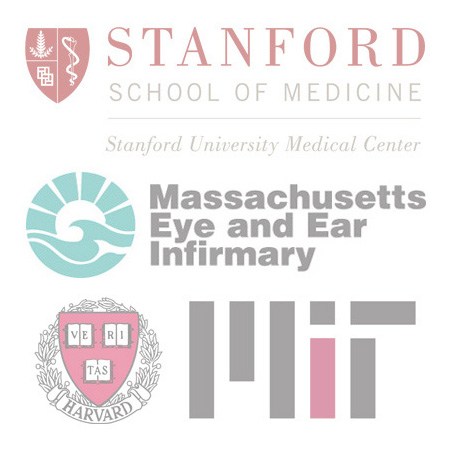Our laboratory works on inner ear development and regeneration, as well as on the biology of sensory hair cells, the mechanosensitive cells of the inner ear. We are located at Stanford University in the School of Medicine and affiliated with the Otolaryngology department. We are proudly affiliated with the Stanford Initiative to Cure Hearing Loss and we thank all supporters of this endeavor.
We are interested how the inner ear develops from an early anlage called the otic placode. Our goal is to describe the otic lineage from an early placodal progenitor until it splits up in multiple cell types making up the sensory epithelia, innervating ganglia, and accessory structures.
In parallel, we apply knowledge we gained from guiding embryonic and induced pluripotent stem cells along the otic lineage to find ways for treatment of hearing loss. This involves identification of mechanisms of sensory hair cell regeneration in animals such as chickens that recover naturally from hearing loss, screening for potential regenerative targets that can be activated with drugs, and exploring reprograming as well as cell transplantation strategies.
The image shown above is an artistic view of E15 utricle hair bundles overlaid with CellTrails-inspired art. SEM credit goes to Rachel Dumont and Peter Barr-Gillespie (OHSU and the Vollum Institute). CellTrails maps and artistic rendering was done by Daniel Ellwanger.
We are looking for a bioinformatics postdoctoral fellow. The successful candidate has a PhD in bioinformatics or computational biology. Strong interest in single cell trajectory analysis, and creative ability in data presentation, computer animation, and enthusiasm for bioart/biocreativity is a requirement. We expect strong work ethics, vision, and ability to independently learn and implement new technologies.
If you are interested in joining our group, please send a single introductory paragraph and your CV to Stefan Heller at hellers@stanford.edu
Who are we?
April 2018

Current Laboratory Members:












• Ellwanger, Daniel C., Scheibinger, Mirko ., Dumont, Rachel A., Barr-Gillespie, Peter G., and Heller, Stefan. Transcriptional Dynamics of Hair-Bundle Morphogenesis Revealed with CellTrails. Cell Reports, 23(10). doi: 10.1016/j.celrep.2018.05.002 (2018). Link to the paper in Cell Reports.
The software implementation of CellTrails is a whole different piece of substantial work and is available via this link.

This paper began with a discussion between Peter and Stefan at the ARO meeting in 2014 where we wondered whether it would be feasible to determine when individual genes become actively expressed during bundle growth and maturation. Mirko and Rachel were drawn in to identify the best time point during development when hair cells at all stages of development were present in the developing chicken utricle. Mirko profiled >1,000 cells. Daniel took on the complex challenge of finding an unsupervised computational method to order the single cells along a trajectory that reflects hair bundle maturation and undertook a “tour-de-force” of developing a set of algorithms and their practical realization (CellTrails). The unbiased method consists of innovations and implementations that can be used for a variety of analysis steps including dimensionality reduction, clustering of single cells, determining the number of distinct clusters, as well as the computation and analysis of branching cellular trajectories, including the inference of gene expression dynamics. Moreover, CellTrails has an elegant visualization tool that is scalable and therefore compatible with datasets that contain large cell numbers. Flexible trajectory extraction and alignment of trajectories allowed us to compare the expression dynamics of the development of spatially distinct hair cell types with different hair bundle shapes. Ultimately, our study shows that it is indeed feasible to order developing vestibular hair cells based on the sequential expression of hair bundle genes alone. Peter’s lab had a impressive toolbox of antibodies to hair bundle proteins that were essential for Mirko’s validation analyses using high resolution microscopy. We utilized the length of the hair bundle as a biological ruler to relate gene expression dynamics with hair bundle length. Our analysis revealed that control of local Ca2+ is important for hair bundle growth and moreover, it identified distinct subtypes of vestibular hair cells, which indicates that the number of hair cell subtypes in the utricle is larger than previously thought.
Software Implementations
• CellTrails (via this link)
• Heller lab simple guide to single cell analysis (coming soon)

My goal for this year is to provide more frequent updates. Congratulations to Amanda for being selected as recipient of an A.P.…

Another year went by. Here are some highlights. Postdoc Mirko Scheibinger got the February cover of JARO with his paper describing the…

A sign of life! The silence was an indication that we have been busy. I just wanted to post here that a longer…

2016 has been fairly good to us thus far. Our new NIH grant received a competitive score, which is most important…